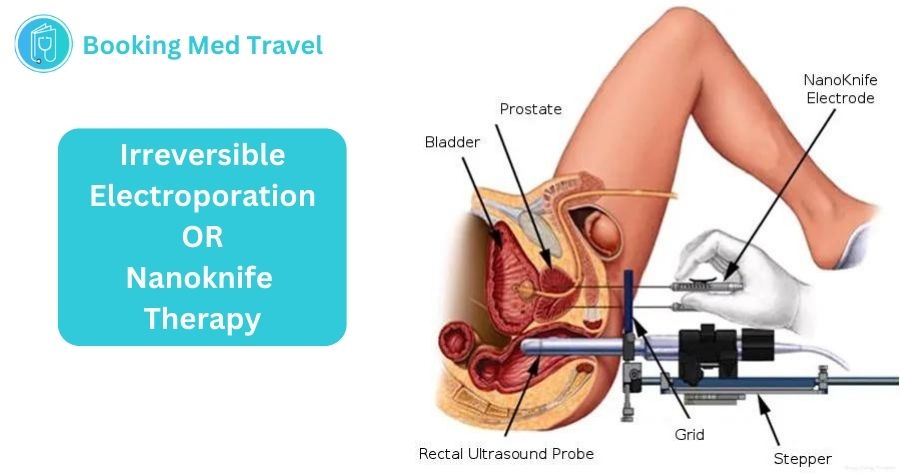
Due to the unwanted benefit-risk ratio of traditional treatments in prostate cancer, different randomized controlled trials have been made to look for treatments with higher efficacy and lower side effects.
One of the reasons for increased risk is the fact that the treatments are usually given in a way that gives rise to collateral tissue damage and side effects due to radical whole-gland surgery or radiotherapy causing erectile dysfunction in approximately 40 to 95% of patients, urinary incontinence in 10 to 20% and bowel toxicity in around 5 to 35% of patients after undergoing radical therapy.
Modern medicine is leaning towards decreasing those side effects by trying new therapeutic minimally invasive methods such as targeted focal therapy for prostate cancer. One of these targeted focal therapies is irreversible electroporation therapy which includes the use of a NanoKnife device to kill the prostate cancer in its early stage.
What is irreversible electroporation (IRE) or Nanoknife therapy?
Irreversible electroporation (IRE) therapy also known as Nanoknife therapy is a selective therapy for prostate cancer. It is a minimally invasive technique used in the initial stage of prostate cancer for the treatment of tumors that are inaccessible and hard to operate on.
Irreversible electroporation is a method that can treat prostate cancer as well as other types of cancer, by means of quick electrical pulses. These electrical pulses are generated from the electrodes that are placed in or around the tumor and cause damage to the membrane of the cancer cell eventually causing cell death.
This kind of focal therapy for prostate cancer can target malignant cells with high accuracy.
Thanks to the preoperative MRI scan guidance, the electrical pulses can selectively target the exact tumor area, without damaging the surrounding healthy tissue.
Unlike Cryoablation or Microwave ablation which uses thermal treatment to destroy tissue, the Nanoknife (IRE) therapy treats without exposing the tissue to extreme cold or heat, therefore, eliminating the major cause of treatment failure and possible damage to the tissues adjacent to the treatment area.
How is irreversible electroporation or Nanoknife therapy performed?
- The patient is first put under general anesthesia and deep muscle paralysis
- A suprapubic catheter is then inserted. However, in the case of contraindication, a urethral catheter is inserted.
- The electrode needles are then inserted under the guidance of transrectal ultrasound (TRUS) with the help of a brachytherapy grid for the accurate placement of needles.
- After placing the electrodes in the margins of the tumors, the electrical field is then generated in the micro and millisecond range.
- The device provides 90 pulses with a pulse length of 70 μs which generates an electrical field between 20 and 40 A. This current can totally ablate the targeted tumor zone without producing heat which damages the surrounding tissue.
- The electrical pulses produce pores in the cell membrane which eventually results in cell death.
P.S: Generally, four electrodes are necessary to cover the prostate lesion. However, another electrode can be required for bigger lesions.
The treatment duration ablating a 2 cm lesion is typically less than 5 minutes with no stitches, only a small bandage.
In addition, side effects and pain are minimal and patients usually leave the hospital on the same day of the surgery.
Indications for Irreversible electroporation (Nanoknife) therapy
It is important to know that the procedure is new and is not accessible in every hospital or clinic. Nanoknife (IRE) therapy can be used in two cases:
- Either to treat the initial stage prostate cancer patients
- Or recurring prostate cancer that has not been metastasized, in other words in the case of recurrent localized prostate cancer.
Follow-Ups after Irreversible electroporation (Nanoknife) therapy
It is important to know that follow-up appointments are essential after the therapy.
Following post-therapy examinations are conducted to assess the effect of the treatment:
- MRI scan in order to make sure that the tumor is shrinking
- Repeated biopsies to make sure no residual cancer cells remain
- PSA analysis at regular intervals to make sure there is no recurrence.
Follow-up studies of Irreversible electroporation (Nanoknife) therapy
Different follow-up trials have been made in order to better understand the success and safety of Nanoknife (IRE) therapy. Here we present to you the summary of those studies:
- The most crucial predictor of mortality in localized prostate cancer is Gleason's score.
During a period of 15 years of follow-up for patients that underwent treatment with Nanoknife, the patients with Gleason of 6 (3 + 3) hardly had metastasis or died from prostate cancer. - The efficacy of Nanoknife therapy was also assessed by local tumor control or recurrence-free survival. The rise in PSA value in combination with mpMRI and PSMA-PET/CT scan image result was the indicator of prostate cancer recurrence.
Throughout the 6 years of follow-up, only 10% of recurrence was observed. - Another study on 123 patients with the goal of assessing the residual of the disease in biopsy-follow-up showed that 90 to 97% of the patient’s biopsy was clear of residual disease. In addition, 96% of patients didn’t have to undergo total gland treatment after 3 years.
Overall, Nanoknife therapy for early-stage prostate cancer showed long-term satisfactory oncological results in addition to the minimal influence on the quality of life of patients.
Cost of irreversible electroporation (Nanoknife) therapy in Germany
The duration and intensity of the Nanoknife therapy for prostate cancer depends on case to case basis. Therefore, only approximations of the price are possible.
Usually, German patients and foreign patients pay the same price since the bill fulfills constitutional cost catalogs. However, travel expenses, costs for translation, and accommodation increase the overall expenses for patients who are explicitly from abroad.
In the case of personalized treatment services such as a single room or surgery request by the head physician, prices increase even further.
The cost of irreversible electroporation or Nanoknife therapy for prostate cancer in Germany usually ranges between 15,000-25,000 Euros.
Advantages of irreversible electroporation or Nanoknife therapy for Prostate Cancer:
Irreversible electroporation is a promising therapy and it shows many advantages, such as:
- It is a negligibly invasive technique.
- It is a non-thermal therapy, therefore, it can treat tumors that cannot be treated with thermal therapy.
- It can treat tumors that are mainly close to vital structures such as large blood vessels, bowel, nerves, and ducts.
- It can treat tumors that are hard to treat with minimally invasive techniques or with salvage therapies.
- It requires only a short stay in the hospital or clinic.
- It has a quick period of recovery, which is generally only a couple of days.
- It is a pain-free treatment with negligible side effects or no side effects at all.
- There is a possibility of repeating the therapy in case of tumor recurrence.
Disadvantages of irreversible electroporation or Nanoknife therapy for Prostate Cancer:
Even though the therapy has various advantages, it also has some limitations such as:
- The therapy necessitates general anesthesia and it is more expensive compared to other focal therapy techniques.
- The catheter may stay inserted for a few days.
- Reduced or no ejaculatory fluid that may lead to infertility in some patients.
- Some patients showed erectile dysfunction as well.


Comments